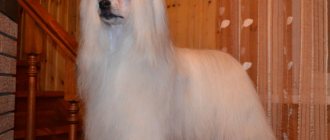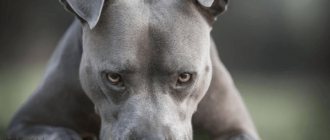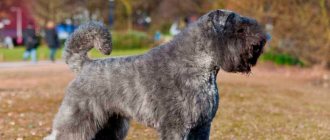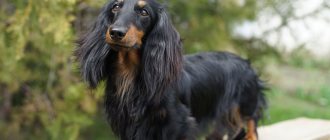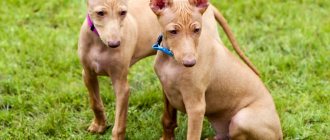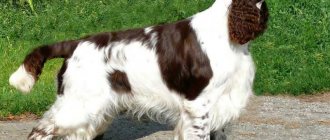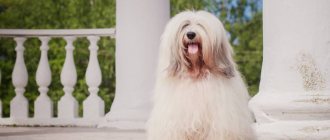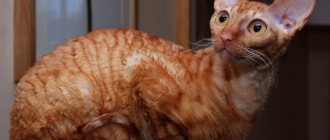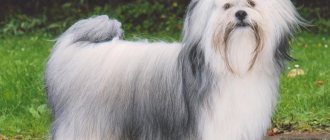History of the origin of the breed
The Northern Inuit dog breed was originally developed in the late 1980s in Canada, and some time later brought to England. There are several versions of its origin. The first is to say that the founder of the breed is breeder Eddie Garrison, who crossed a Siberian Husky, an Alaskan Malamute and a German Shepherd with a good pedigree and got the first Canadian Husky. The main goal of the breeder was to create a dog that looked like a wolf, as well as with wolf strength, endurance and unpretentiousness, but with a good-natured, easy-going disposition, ideal for a companion dog.
The second version regarding the origin of the breed says that several Canadian Eskimo dogs or Labrador Huskies were brought to the United States from England in the late 70-80s of the 19th century, where they were crossed with the Alaskan Malamute and the German Shepherd. For many years, in addition to the main breed club, pets were members of the following organizations: Inuit Dog Association, British Forest Dogs, British Inuit Dog Club, etc. However, none of these clubs was recognized by major dog breeding organizations. To date, the Canadian Husky breed is not recognized by any major kennel club, but only by its own independent kennel club.
Historical reference
The Northern Inuit is the result of the hard work of dog handlers trying to breed a dog that has the characteristics of a wolf. This breed is relatively young and dates back to the 80s of the 19th century.
There are two possible versions of its origin:
- According to the first, the ancestor of the breed is Eddie Garison, who, by crossing a young litter of German shepherds, Siberian huskies and Alaskan malamutes, got the northern Inuit dog.
- According to the second theory, Canadian Eskimo dogs or Labrador Huskies were brought to Britain from America, where they were crossed with the Alaskan Malamute and the German Shepherd.
Thus, the wolf-like dog does not have the genes of its wild “relative” - the wolf.
To date, several breeds of “wolf dogs” have been developed that have the wolf gene. But this feature makes dogs timid and difficult to train. In this regard, scientists abandoned the wild animal gene when creating the northern Inuit dog.
The Northern Inuit Dog is a laboratory pet that combines the characteristics of a wolf and a domestic dog.
The dog's homeland is considered to be Great Britain.
Most dog handlers do not recognize the creation of hybrids, that is, the creation of new breeds from already formed ones. Therefore, the Northern Inuit dog is still not recognized by the International Canine Organization. This breed is recognized only by a few amateur dog breeders and professionals involved in its breeding.
In 2011, dogs of this breed appeared before moviegoers as direwolves in the first season of the series Game of Thrones. It is known that one of the furry actors was taken in by Sophie Turner, who plays Sansa Stark, after filming.
In 2011, the Inuit appeared before moviegoers as direwolves in the first season of the series Game of Thrones.
Description of the breed
The Northern Inuit is very similar to a wolf; the dog is quite large, strong, hardy, courageous and stubborn. According to the standard, which is never officially recognized, representatives of the breed have the following appearance characteristics:
- Body type: rectangular, strong, muscular, flexible, athletic. The chest is deep, wide, with developed muscles. The belly is tucked up, the neck is long, muscular, wide, smoothly blending into the body.
- Dimensions: the height of males at the withers is 58-81 cm, females 58-71 cm. Weight of males 36-50 kg, females 25-38 kg.
- Head: wedge-shaped, with a low forehead.
- Muzzle: elongated, narrow, jaws well developed, teeth strong and sharp.
- Nose: medium size with wide nostrils, the lobe matches the color of the coat.
- Eyes: oval, medium size, slightly raised outer corner, yellow-brown, amber or bluish in color.
- Ears: large, low set, triangular in shape, wide at the base, erect.
- Limbs: long, strong, smooth, with large joints. The paw pads are large and collected together. The claws are very strong, bent back.
- Tail: straight, medium length, covered with thick hair.
- Coat: medium long, hard, thick, with dense undercoat.
- Color: white or black, sometimes there is a sable pattern on the main color.
- Life expectancy is 12-14 years.
Tamaskan dog
The Tamaskan is considered a large dog with an athletic build, which from a distance can be mistaken for a gray wolf. This rare breed from Finland is the result of crossing Siberian Huskies, Alaskan Malamutes and German Shepherds. The result was a dog with a typical wolf appearance, a developed and flexible body and excellent working characteristics.
Remember how Robb Stark's direwolf took part in many battles side by side with his master? This is a characteristic feature of Tamaskan - it will protect itself and the one to whom it is transferred in any situation.
Overall, this is a good family dog. Gentle with children, she gets along well with other pets, which makes her completely different from the characters in the movie saga.
Main features of the breed:
- dexterity, agility;
- obedience;
- high level of discipline.
Character traits and training
Despite his rather vicious appearance, the northern Inuit dog has a calm and friendly disposition; he will never show aggression without a reason. Also, dogs of this breed are very smart, quick-witted, cheerful, active and sociable. They get along well with children, but you should not leave the dog alone with them.
These agile and active animals often show their stubbornness and leadership qualities, so the owner must train the puppy from an early age and show who is in charge. Pets have a specific character and are difficult to train, since wolf blood makes the dog a little wild. The owner of a Canadian husky must be strong, patient and never submit to his pet; this is the only way he can succeed in training.
Character and training
A few successful owners will confirm that the character of the northern Inuit is complex and more than specific . If we consider the data of the ancestors (mongrel of the aboriginal type, service and sled breed), this statement does not seem surprising. However, Inuit perform well on film sets (for example, they play direwolves in Game of Thrones), work in special services to search for narcotic substances and in rescue services to search for people. The conclusion is obvious, the Inuit is trainable and obedient if you find an approach to it.
Each dog is individual, especially if it belongs to an unstudied breed. Domestic wolves are prone to dominant aggression and are therefore not recommended for families with children or other animals. The owner will also have to defend his alpha place, at least until the pet is 2-3 years old.
Otherwise, Inuit are very smart dogs, they understand and feel people well, and learn commands and tricks. Unlike service breeds, they do not tolerate monotony in training and need more games. Inuit can be bred to guard the home, since protection of the territory, the owner and his property is inherent in the character of dogs at the genetic level.
Representatives of the breed are very attached to their owners, too much for the latter to allow themselves holidays abroad or similar events. When left at home (without its owner), the dog will initially suffer from severe stress and then develop a condition called separation anxiety.
Maintenance and care
Representatives of the breed can be kept in a house or apartment, but the dogs will feel best on the street. Since Inuit are northern dogs, their coat is very dense and thick, which allows the dogs to withstand different temperatures well. Dogs are very active, and to maintain good health and physical fitness, you need to give them the opportunity to walk a lot and provide intense exercise.
Dogs of this breed do not require special care; it is enough to regularly carry out the following hygiene procedures:
- comb out wool;
- bathe your pet;
- trim claws;
- clean ears from wax and teeth from plaque;
- wipe your eyes from sourness;
- as a preventive measure, give anti-worm medications;
- treat fur for fleas.
Domestic wolf? Northern Inuit dog!
Contents hide
Domestic wolf? Northern Inuit dog!
This is probably how man is made. Well, you want something exotic, and that’s it. It would seem - choose any domestic cat. There are so many breeds in the world to suit literally every taste! But no - give me a tame cheetah, serval or caracal. As a last resort - savannah or chausie. The same situation occurs with dogs. There are huskies, huskies, malamutes. Take a puppy and enjoy life. But it’s not interesting: if you’re going to raise a wolf, then by all means!
Do you really want a gray wolf? But maybe it’s still not necessary? Note the Northern Inuit dog. Introduce her to your friends and neighbors as a wolf - probably no one will notice the catch. You've probably already met these wonderful dogs. At least while watching the cult series “Game of Thrones” - many dogs of this particular breed were involved in the filming.
What is the Northern Inuit Dog? Experts classify it as a so-called “cross” breed. This breed is the result of the hard work of breeders who tried to get a dog incredibly similar in appearance to a wolf. It seems that they coped with their task. The breed is relatively young - its history begins in the late 80s. last century. The program included German shepherds, Siberian huskies, Alaskan malamutes and some other breeds. You can buy any Northern Inuit puppy you like. Which breed genes will be prevalent in each specific puppy? It's very difficult to say. It may happen that there are traces of only two breeds in your puppy. This is the beauty of “crosses”!
The result, however, exceeded all expectations. The dogs came out fearless, brave and determined. They have a highly developed protective instinct. Of course, the northern Inuit are active and have inexhaustible energy.
Is this a purebred dog? Alas, the northern Inuit dog is not officially recognized by any cynological organization in the world. Accordingly, there is no official breed standard. By the way, you can also try yourself as a breeder by crossing, for example, a husky and an Alaskan malamute. And, essentially, you will have your own little “Inuit.” Parents may have a brilliant pedigree, but their common puppy, alas, will be officially considered outbred.
How much does it cost, where to buy. Single advertisements for the sale of Northern Inuit puppies sometimes appear on popular Internet sites. But such advertisements are placed extremely rarely. Not a single nursery in Russia works with the breed (yet?). And lovers of exotics (in particular, direwolves) have to look for puppies in roundabout ways, sometimes shelling out a fortune (prices of 250-400 thousand rubles are not the limit). Unscrupulous people often profit from puppies by passing off huskies and other breeds as Inuit. Please be vigilant and do not be deceived. The best way to become the owner of a “purebred” puppy is to write to a Western (preferably British) nursery. Yes, you will have to wait - there is a steady demand for puppies. The price of such a puppy will be approximately 50 thousand rubles plus the cost of transportation.
Cost of ownership. As one might expect, the Northern Inuit is a very large dog. So get ready for the accompanying serious expenses - food, accessories, regular visits to the veterinarian. Having something so exotic is a very expensive pleasure!
Temperament and character. To be honest, you can’t describe it in a few words! Dogs are lively, active, inquisitive and even curious. They love to stick their nose everywhere. They have the ability to get into places where they don’t particularly ask. They do it just like that - out of sporting interest.
Dogs are social and have a highly developed pack instinct. They prefer the company of other dogs and feel good there, usually occupying leading roles. Sometimes genes received from a German shepherd wake up in puppies - they are drawn to exploits, they need to look for something, protect someone, etc.
Inuits, according to reviews from a few owners, are completely devoid of fatigue. Not dogs, but perpetual motion machines. Ready to run and rush all day long. Accordingly, potential owners need to prepare for this - provide their pets with the opportunity to exercise at least several hours a day. The Inuit are prone to independence and can afford to escape. Therefore, take care of a strong leash and a high fence in advance.
If you do not have enough experience, then sign up for special courses under the guidance of an experienced trainer. You can’t let everything take its course – you run a great risk of losing control over your own dog.
Who is Northern Inuit suitable for? As you can see, he cannot be considered a “dog for everyone.” You should lead an active lifestyle and have plenty of free time. Finally, we have accumulated experience working with strong and large dogs of hunting and service breeds. We would under no circumstances recommend getting an Inuit just like that, “for the sake of exoticism.” Not the case.
Photo: dog-news.ru (from open sources).
Health
The Northern Inuit is a fairly strong dog, which nature has endowed with not only good strength, but also excellent health. However, like dogs of other breeds, pets suffer from the following genetic diseases:
- hip dysplasia;
- dislocation of the elbow joint;
- glaucoma;
- epilepsy;
- Addison's disease;
- allergy;
- chondrodysplasia.
With timely prevention and regular visits to the veterinarian, the above diseases can be easily avoided.
Nutrition
The Northern Inuit dog is quite large and grows quickly, so it needs a balanced diet rich in vitamins and minerals. However, it should be noted that dogs of this breed suffer from food allergies. Your pet's menu must include fresh meat, bones, fish, offal, cereals, vegetables, dairy products and eggs. All products should contribute to the normal development of the animal, strengthening bones, teeth and joints. The northern husky needs to be fed 2 times a day in small portions. Inuit have a voracious appetite; if the pet constantly overeats, this can lead to illness and obesity.
Caring for a Northern Inuit Dog
The Northern Inuit dog does not require any special care. To make it look neat, you need to follow some simple rules:
- bathing - once every 2-3 months;
- combing the coat - once a week, daily during shedding (the dog sheds very heavily twice a year);
- daily brushing of teeth;
- nail trimming - once every 2-3 weeks;
- regular ear cleaning.
The intense shedding of the Northern Inuit dog is one of the reasons for keeping your pet outside.
Video: Northern Inuit dog being brushed while shedding
Training and raising a pet
It is necessary to start raising an exotic pet from childhood, otherwise all attempts will be unsuccessful. During training, you need to show persistence and patience. You cannot show your weakness and vulnerability. The dog quickly picks up commands and carries them out, but at the same time, it requires a reward for its obedience, so a treat as a reward will not be superfluous. The pet does not tolerate violence and rudeness.
The Northern Inuit dog can be taught not only basic skills, but also circus tricks; the main thing is to catch the emotional state of the pet and be on the same wavelength with it.
Specially trained dogs of this breed take part in searching for people and detecting drugs.
If you are not confident in your abilities, then it is best to seek help in training from dog handlers.
Walking with a Northern Inuit
An Inuit dog that is kept in an apartment requires regular walks in the fresh air twice a day. The duration of one walk is at least one hour. To maintain health and muscle tone, your pet needs daily physical exercise and active rest. He will be happy to kick the ball with his owner and run races. The dog loves water, so it will not refuse to swim in a clean pond.
Breeders of this breed pay attention to the fact that during the formation of the skeletal system it is necessary to limit the load on the musculoskeletal system of the puppies and prevent jumping from heights.
Video: Northern Inuit dog plays with owner
What to feed your Northern Inuit dog
Inuit can eat equally well on dry food or home-cooked food. But if the choice falls on the first, then it should be premium food, since the northern Inuit dog is prone to allergic reactions. Two feedings a day are sufficient (three times a day for puppies). One serving is calculated based on the weight of the pet:
- 25 kg - 332–445 g;
- 36 kg - 352–463 g;
- 38 kg - 381–501 g;
- 50 kg – 402–521 g.
It is important to consider the ratio of proteins and fats in the diet: 50% and 15%, respectively.
Food products that should be on your pet's menu:
- cereals;
- coarse, sinewy lean meat (you need to be careful with chicken, as it can provoke allergic reactions);
- lean fish once a week;
- fermented milk products;
- vegetables.
Where to buy a Northern Inuit dog puppy, price
Buying a Northern Inuit dog puppy is not easy, as it is an unrecognized breed. However, it is quite in demand in Russia and Ukraine; it is bred in Moscow, St. Petersburg, Yekaterinburg, Kyiv, Odessa, Lvov and other cities. You can buy purebred Northern Inuit dog puppies from breeders, in nurseries, from fanciers, through advertisements on Avito and OLH.
How much does a Northern Inuit dog cost? The price of a puppy in Russia on Avito and in Ukraine on OLH varies between 3,000-6,000 dollars. But the cost, of course, depends on the pedigree, boy or girl, and other factors. For a purebred pet with a good pedigree, you will have to pay significantly more. There are also forums, groups on VK (VK, VKontakte), Facebook (FB), where pets are given inexpensively, free of charge, into good hands, for free (if someone agrees to accept the gift). To begin with, we recommend watching a video with this animal, a photo (there are many cool photos with a person), reading reviews from satisfied owners, articles on Wikipedia, and making a choice.
Northern Inuit Dog Health
The average lifespan of a Northern Inuit dog is 12 years. With proper care, she can reach 18 years. Representatives of this breed are susceptible to the following genetic diseases:
- Food allergies. An environmentally friendly habitat has become the reason that dogs can suffer from food allergies to industrial feed, as well as food. It is quite difficult to recognize the first signs of the body’s reaction due to the thick coat. Treatment, as a rule, is prescribed only by a veterinarian and includes a whole range of measures, including taking medications and regulating nutrition.
- Epilepsy. Dogs of this breed are prone to sudden onset of seizures. With congenital epilepsy, the first attacks usually occur at the age of six months, then under the influence of negative factors they can worsen and become more frequent. During an attack, the dog begins to whine nervously, worry, salivation increases, and then there is a loss of consciousness. Epilepsy should be treated only under the supervision of a veterinarian.
- Hip dysplasia is a disease in which the patella, which consists of three parts (thigh, patella and tibia), is incorrectly positioned. The disease manifests itself throughout life in the form of lameness or abnormal gait. An underdeveloped joint or one damaged as a result of injury with constant contact “erases” the cartilage tissue, causing pain. The destruction process then affects the bone. If the disease is detected in the early stages of its development, it is possible to stop the process, otherwise the dog will remain disabled.
